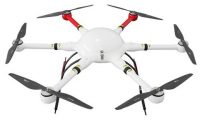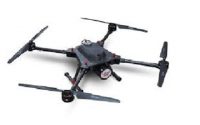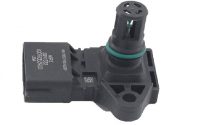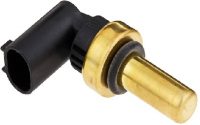BC337 Transistor : Pin Configuration & Its Applications
A semiconductor device like the BC337 transistor is used to switch or amplify electronic signals as well as power. It is composed of semiconductor material generally with a minimum of three terminals to connect an exterior circuit.
Once current or voltage is applied to one pair of the transistor terminals then it controls the flow of current by another pair of transistor terminals because the o/p power is higher as compared to input power. This article discusses an overview of the BC337 transistor and its working.
What is BC337 Transistor?
BC337 is a three-terminal NPN transistor like emitter (E), collector (C) & base (B). This kind of transistor is mainly used for switching & lowers power audio amplification purposes. This transistor includes 3- layers where one layer is p-doped & the remaining two layers are n-doped.
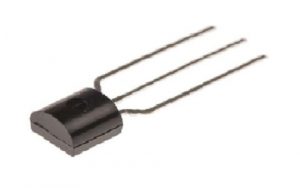
Here, the layer doped with P is arranged in between two layers doped with N. The base terminal of the transistor is positive whereas emitter and collector terminals are negative. In this transistor, the majority of charge carriers are electrons.
It is very important to note that, as compared to PNP, NPN transistors are mostly preferred due to the movement of electrons is very better & faster than the movement of holes. In most electronic projects, the combination of both the PNP & NPN transistors is used.
Working Principle
In NPN, the flow of current direction will be from collector terminal to emitter whereas, in PNP, it will be from emitter terminal to collector. So the overall transistor performance mainly depends on the base terminal because, once the voltage supply is provided to the base terminal, it will bias then immediately emitter terminal emits charge carriers. After that, the charge carriers will be controlled through the base terminal and finally, the collector terminal collects the charge carriers.
The controlling of large current at emitter and collector terminals can be done by the small current at the base terminal. So this kind of process is mainly used for amplification. This transistor works like a switch to convert the small current to a larger current at the transistor terminals.
The base terminal is positive as compared to both the terminals like emitter & collector. As compared to the emitter terminal, the voltage at the collector terminal is positive always. So the resistor is used at this terminal to control the current flow.
Pin Configuration
The pin configuration of the BC337 Transistor is shown below. This transistor includes three terminals where each terminal and its purpose are discussed below.
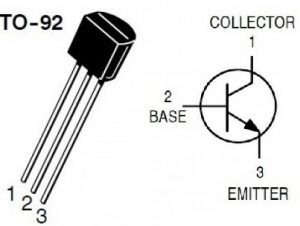
- Pin1 (Collector): This terminal is connected to load where the current supplies throughout the collector terminal.
- Pin2 (Base): The base terminal is used to control the transistor biasing like ON/OFF
- Pin3 (Emitter): This terminal is used to drain out the current & this terminal is normally connected to GND.
Features & Specifications
The features and specifications of the BC337 transistor include the following.
- The type of package is TO-92
- NPN type transistor
- The technology used to process is advanced
- The voltage used is low error
- Switching speed is fast
- Complete voltage operation
- High power handling capacity
- Collector Current max is 0.8A/800mA
- Voltage from Collector to Emitter terminal Max (VCE) is 45V
- Voltage from Collector to Base Max (VCB) is 50V
- Voltage from emitter to base Max (VBE) is 5V
- Collector dissipation max is 625 Watt
- Transition frequency max is 100 MHz
- DC Current Gain min & max ranges from 100 to 630
- Max operating & storage temperature must range from -55 to +150 Centigrade
Alternative transistors of BC337 are 2SC3912, 2SC3914, BCX19, 2SC3913, BC817 & 2SC3915.
BC337 NPN transistor includes some good characteristics. This small TO-92 transistor has several features so that it can be suitable in different electronic circuits.
The maximum voltage allowed through the collector terminal to the emitter is approximately 45V which makes to use in different electronic circuits. These circuits work above 24V. The maximum gain of this transistor will make to use in the amplification of audio frequency circuits.
How to Run a BC337 Transistor Very Safely in a Circuit?
This transistor is operated very securely for a long time when it operates below -45V DC. An appropriate transistor is connected to the base terminal of this transistor. We should not provide the load to this transistor above -100mA.
The temperature must be under -65 to +150 Centigrade around the transistor. Need to check the pin configuration before connecting it to the circuit. If the transistor is placed wrongly then it may get damaged or the circuit will not work.
Where to use BC337 Transistor?
The simple relay switch circuit using the BC337 transistor is shown below. This circuit includes a coil that is driven through an NPN transistor like BC337switch based on the input voltage range.
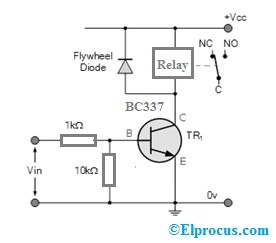
Once the voltage at the base terminal of this transistor is negative or zero then this transistor will work as an open switch. So in this state, there is no current at the collector terminal & the relay coil is de-energized. If there is no current supply at the base terminal, then there is no flow of current in the relay coil.
If a large current is supplied throughout the base terminal to saturate the transistor, then the current supplying through the base terminal to the emitter will control the current in the relay coil supplying throughout the transistor from the terminals like a collector to emitter.
The relay coil is not just an electromagnet however it is an inductor. Once power is given to the coil because of the transistor’s switching action, the highest current will supply. Some of this energy can be stored in the magnetic field of the relay coil.
Once the transistor is turned OFF, the flow of current throughout the relay coil will reduce & the magnetic field will fall. But the energy stored in the magnetic field will go anywhere & a reverse voltage can be developed beyond the coil because it aims to keep the current within the relay coil. So this action will generate a high voltage spike beyond the relay coil that can harm the transistor if it increases.
So to protect this transistor, a freewheeling or flywheel diode is allied across the coil. So this diode will clamp the reverse voltage beyond the coil to 0.7V for dissolving the stored energy & also to defend the transistor. Flywheel diodes are used where the supply is polarized DC voltage. An alternating current coil needs a dissimilar protection technique, so the circuit used for this is an RC snubber circuit.
Where to use/Applications
BC337 transistor is used in different electronic circuits & basic electronic projects because of its characteristics. It is also used in audio preamplifier stages due to its high gain feature.
In other techniques, it can also be used for switching small loads within electronic circuits. For instance, to control LEDs, switch ON electronic circuits, bulbs, relays & any kind of load below 800mA.
The applications of the BC337 transistor include the following.
- Amplifiers like small signals & low power
- Used for switching
- Used for amplification & switching
- Audio frequency Driver
- Used to control current in electronic motors
- O/p stage of amplifier
- These transistors are used in pushbuttons.
- Used in multivibrators like Astable & Bistable
- Instrumentation
- Darlington pair circuits
- Robotics
Thus, this is all about an overview of the BC337 transistor datasheet which includes its pin configuration, features, specifications, circuit, and applications. Here is a question for you, what is the PNP complementary transistor of BC337?


